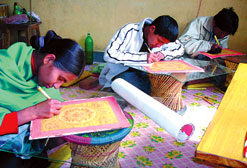 Ministers in the present transitional government know that their freedom to take independent decisions ends where the conditions of bilateral donors and multilateral lenders begin. Since their capacity to introduce fundamental reforms in state policy is limited, they compensate by making cosmetic changes.
Ministers in the present transitional government know that their freedom to take independent decisions ends where the conditions of bilateral donors and multilateral lenders begin. Since their capacity to introduce fundamental reforms in state policy is limited, they compensate by making cosmetic changes.
The UML minister of education couldn't do much to improve teaching and learning at government schools, so he decided to make news by doing away with the list of SLC toppers. Powerful arguments have been made for and against this decision.
However, the pointless controversy over this non-issue has pushed some real concerns out of the media glare: the plight of the 53.49 percent of examinees who 'failed' to get through the exam.
The family values that produced the newly-introduced category of distinction-holders is worthy of sociological analysis. These young seekers of excellence often come out of urban, educated and gainfully employed middle-class families. Most of them will do well in life regardless of the professions they choose. Almost all of them will negate the role of social networks in their professional advancement and claim they rose by the dint of their hard-work, talent and luck. Very few will even remember their SLC batch-mates that fell by the wayside.
But the state can only ignore the future of these involuntary school-dropouts to its own peril. Over half the students that appear for SLC examinations 'fail' every year. Some manage to graduate in subsequent years but most are left out as social rejects. A SLC youth is too 'educated' to plough the fields, cut wood, lay bricks, mend shoes, tailor shirts, sell vegetables, or tend cattle. But they are hardly good for anything else. Little wonder, almost every one of them heads for the manpower agency.
Networks of skill-enhancement institutes for SLC-failed needs to be created to enable the students to lead a life of work and dignity. Tentatively, let's call them Basic Employment Skill Training (BEST) Institutes. By offering four-month long craft-based and artisan courses such as masonry, plumbing, electric fitting, carpentry, vegetable and herb farming, dairying and motorcycle repairs, one BEST Institute can train about 1,000 students a year.
A hundred such schools can easily cater to the needs of over 100,000 students who fall off the SLC ladder every year. An existing infrastructure of government schools at district capitals can be used to run these centres during the evening. DDCs and municipalities can be entrusted with running these centres.
The experiences of Balaju, Lahan, and Jumla technical institutes offer lessons to open, run and manage training centres of smaller scale at dispersed locations. The Technical Instructor Training Institute at Sano Thimi is a centre of excellence in the field, and branches will have to be established in every development region.
Experts will scoff: what can you teach a tenth-grader in four months? But 100 days are enough to impart survival skills. In addition to basic occupational ability, the capacity to fill out forms, open a bank account, keep a record of income and expenses and the curiosity to learn new things are all the skills one needs to get along at the bottom rung of market economy. Progress thereafter depends upon factors beyond the scope of any basic training.
The BEST Institute method would not just rehabilitating school dropouts but also go some way to create the 500,000 new jobs that young Nepalis entering the labour market every year need. All this can only be a powerful antidote to incipient insurgencies.



